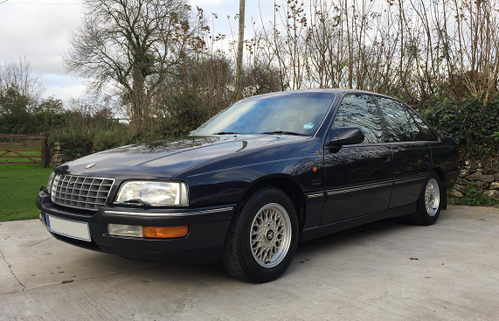A “Director-Level Saloon” - the Vauxhall Senator 24V
16 June 2025
In 2016 Alex Sebbinger-Sparks of the Modern Classic Executive Cars group acquired one of Vauxhall’s finest sports saloons of its era - a Senator 24V. It may now have a new home, but it is hard to forget a car that was the choice of barrister, architect and Chief Constables. Some forces stockpiled the Senator before the end of production in late 1993.

That year, Top Gear magazine evaluated a Thames Valley Police Vauxhall and wrote “you may outrun a cop car, but you’ll never out-brake one”. Some of us of a certain age so associate the Senator with policing that the former Sebbinger-Sparks 24V has the air of an off-duty CID car.
Vauxhall launched the Senator B in 1987 as the 2.5i, the 3.0i or the 3.0i CD. They advised dealers it was for those who had “reached a ‘position’ in life – senior executives, top management, owners of both large and small businesses, and professional people”. The entire range was for “discerning prospects”.
At the same time, the CD was apparently a “director-level saloon” with ABS, cruise control, air-conditioning, and electronic ride control as standard. The sales copy modestly stated: “A computer works out how. It is one of ten boxes of electronic wizardry on the Senator CD. They oversee everything from the seven-function trip computer to the cruise control and one-touch electric windows”.
The CD also came with an LCD fascia straight from Blake’s Seven-style with the no-cost option of analogue dials for the more traditionally-minded driver. Sue Baker
complained: “Vauxhall’s new Senator, in many ways an admirable car, also suffers from a dashboard design theory that is something good, more is better”.
Car found the Senator “a fit alternative” to the Jaguar 3.6 XJ6. Autocar praised the “brilliant chassis” and “formidable standard equipment” but complained “Its performance hardly rates against the opposition”. In 1989, Vauxhall rectified this problem with the 1989 CD 24v. At £25,180, it was £1,250 more expensive than the standard straight-six, but the 24V boasted an engine aspiration system that allowed it to function below 4,000rpm as a pair of three-cylinder units.
With the automatic gearbox, the 24V’s top speed was an impressive 140 mph and it could achieve 149mph in five-speed manual guise. Vauxhall promoted the 24V as having “well-mannered verve” and Sue Baker described it as “a distinguished car with high levels of refinement, comfort and performance”. Meanwhile, a company spokesman, Andrew Andersz told The Observer: “We placed a Senator 24-valve with every mainland police force, and most have been delighted with it”. By 1990, 47 constabularies had a Senator 24V on loan”.
Autocar believed the 24V “deserves to go down as one of Vauxhall’s heroes, and Car thought it “one of the most underrated executive cars around”. However, they also stated that, while it was “one of Vauxhall’s best cars. Yet, it won’t ever threaten Mercedes, as its sales figures proves. Besides, it’s wearing the wrong badge”.
The dealership guide envisaged prospective owners as senior executives who might otherwise have considered the Audi 100 C3, BMW E34 or Mercedes-Benz W124. Unfortunately, by the end of the 1980s, too many buyers were opting for ‘prestige’ marques. By the early 1990s, the combined sales figures of the E34 and W124W
exceeded those of the Senator by six to one. Those discerning buyers who did place an order for the 24V appreciated it was possibly the bargain of the decade.
After all, the Senator 24V was indeed “top-of-the-line Vauxhall motoring”. And as John Langley of The Telegraph noted: “A successful prestige model can have a beneficial effect which rubs off their more mundane models”.
With thanks to Alex Sebbinger-Sparks for his time.
With thanks to Alex Sebbinger-Sparks for the permission to use the images in this blog.
